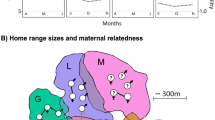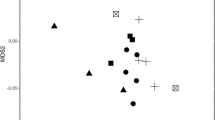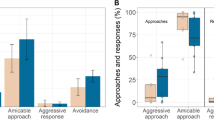Abstract
Group living occurs across the animal kingdom and can shape fundamental aspects of individual biology, including the microbes inhabiting the animal gut. The naked mole-rat, Heterocephalus glaber, exhibits extreme cooperative breeding (eusociality) and presents an ideal opportunity to study the effects of social structure on the mammalian gut microbiota. Within colonies reproduction is limited to few animals, while the remaining members are non-reproductive, form linear dominance hierarchies, and show evidence of task specialization with stable yet plastic behavioral phenotypes. Here, we sequenced the gut bacteria of naked mole-rats across 6 replicate captive colonies and longitudinally during a colony removal experiment. Colony had much larger effects than social phenotype or status on the diversity and composition of gut bacteria. Our longitudinal experiment revealed that over the course of 2 months, the gut bacteria of previously unfamiliar, newly paired animals did not become more similar. In comparison to mice housed in the same facility, the naked mole-rat gut microbiome exhibited substantial compositional differences including the near absence of Lactobacillaceae and the enrichment of Prevotellaceae. Our study provides new insight into the factors shaping gut bacterial communities in social animals and indicates a prominent role of social group membership but not social phenotype.
Significance statement
The social groups to which animals belong can be strong determinants of the composition of their associated gut microbial communities (i.e., gut microbiome). However, less is known about the link between social status within animal groups and the gut microbiome. We studied this relationship in the naked mole-rat, Heterocephalus glaber, which exhibits extreme cooperative breeding (eusociality). Animals within naked mole-rat colonies show clear social hierarchies and evidence of social phenotypes. Across replicate colonies, we found that colony but not social phenotype or status had large effects on the diversity and composition of gut bacteria. During a colony removal experiment, the gut bacteria of newly paired but previously unfamiliar animals did not become more similar over the course of 2 months. Our results show that when decoupled from differences in diet or exposure to microbes, within colony social roles and their accompanying unique physiology and social experience may have little effect on gut microbiota. In contrast, gut bacterial diversity and composition was strongly shaped by colony membership despite being exposed to identical environmental conditions.




Similar content being viewed by others
Data availability
All sequencing files have been archived with the National Center for Biotechnology Information Sequence Read Archive (NCBI SRA) under accession PRJNA635135. All data required to reproduce the analyses can be found at https://figshare.com/s/3edbe9c9df1d2832c9ab.
Code availability
All code required to reproduce the analyses can be found at https://figshare.com/s/3edbe9c9df1d2832c9ab.
References
Alexander RD (1974) The evolution of social behavior. Annu Rev Ecol Syst 5:325–383
Amaral WZ, Lubach GR, Proctor A, Lyte M, Phillips GJ, Coe CL (2017) Social influences on Prevotella and the gut microbiome of young monkeys. Psychosom Med 79:888–897. https://doi.org/10.1097/PSY.0000000000000454
Amato KR, Van Belle S, Di Fiore A, Estrada A, Stumpf R, White B, Nelson KE, Knight R, Leigh SR (2017) Patterns in gut microbiota similarity associated with degree of sociality among sex classes of a Neotropical primate. Microb Ecol 74:250–258. https://doi.org/10.1007/s00248-017-0938-6
Antwis RE, Lea JMD, Unwin B, Shultz S (2018) Gut microbiome composition is associated with spatial structuring and social interactions in semi-feral Welsh Mountain ponies. Microbiome 6:207. https://doi.org/10.1186/s40168-018-0593-2
Bailey MT, Dowd SE, Galley JD, Hufnagle AR, Allen RG, Lyte M, (2011) Exposure to a social stressor alters the structure of the intestinal microbiota: implications for stressor-induced immunomodulation. Brain Behav Immun 25:397–407. https://doi.org/10.1016/j.bbi.2010.10.023
Barker AJ, Veviurko G, Bennett NC, Hart DW, Mograby L, Lewin GR (2021) Cultural transmission of vocal dialect in the naked mole-rat. Science 371:503–507. https://doi.org/10.1126/science.abc6588
Benjamino J, Graf J (2016) Characterization of the core and caste-specific microbiota in the termite. Reticulitermes Flavipes Front Microbiol 7:171. https://doi.org/10.3389/fmicb.2016.00171
Bolyen E, Rideout JR, Dillon MR et al (2019) Reproducible, interactive, scalable and extensible microbiome data science using QIIME 2. Nat Biotechnol 37:852–857. https://doi.org/10.1038/s41587-019-0209-9
Bravo JA, Forsythe P, Chew MV, Escaravage E, Savignac HM, Dinan TG, Bienenstock J, Cryan JF (2011) Ingestion of Lactobacillus strain regulates emotional behavior and central GABA receptor expression in a mouse via the vagus nerve. P Natl Acad Sci USA 108:16050–16055. https://doi.org/10.1073/pnas.1102999108
Buffington SA, Di Prisco GV, Auchtung TA, Ajami NJ, Petrosino JF, Costa-Mattioli M (2016) Microbial reconstitution reverses maternal diet-induced social and synaptic deficits in offspring. Cell 165:1762–1775. https://doi.org/10.1016/j.cell.2016.06.001
Callahan BJ, McMurdie PJ, Rosen MJ, Han AW, Johnson AJA, Holmes SP (2016) DADA2: high-resolution sample inference from Illumina amplicon data. Nat Methods 13:581–583. https://doi.org/10.1038/nmeth.3869
Coen CW, Bennett N, Holmes MM, Faulkes CG (2021) Neuropeptidergic and neuroendocrine systems underlying eusociality and the concomitant social regulation of reproduction in naked mole-rats: a comparative approach. In: Buffenstein R, Park TJ, Holmes MM (eds) The extraordinary biology of the naked mole-rat. Springer, New York, pp 59–103
Cong W, Xing J, Feng Y et al (2018) The microbiota in the intestinal and respiratory tracts of naked mole-rats revealed by high-throughput sequencing. BMC Microbiol 18:89. https://doi.org/10.1186/s12866-018-1226-4
Debebe T, Biagi E, Soverini M et al (2017) Unraveling the gut microbiome of the long-lived naked mole-rat. Sci Rep 7:9590. https://doi.org/10.1038/s41598-017-10287-0
Degnan PH, Pusey AE, Lonsdorf EV, Goodall J, Wroblewski EE, Wilson ML, Rudicell RS, Hahn BH, Ochman H (2012) Factors associated with the diversification of the gut microbial communities within chimpanzees from Gombe National Park. P Natl Acad Sci USA 109:13034–13039. https://doi.org/10.1073/pnas.1110994109
Donovan M, Mackey CS, Platt GN, Rounds J, Brown AN, Trickey DJ, Liu Y, Jones KM, Wang Z (2020) Social isolation alters behavior, the gut-immune-brain axis, and neurochemical circuits in male and female prairie voles. Neurobiol Stress 13:100278. https://doi.org/10.1016/j.ynstr.2020.100278
Dyer BD (1998) A hypothesis about the significance of symbionts as a source of protein in the evolution of eusociality in naked mole rats. Symbiosis 24:369–383
Edwards PD, Mooney SJ, Bosson CO, Toor L, Palme R, Holmes MM, Boonstra R (2020) The stress of being alone: removal from the colony, but not social subordination, increases fecal cortisol metabolite levels in eusocial naked mole-rats. Horm Behav 121:104720. https://doi.org/10.1016/j.yhbeh.2020.104720
Ezenwa VO, Williams AE (2014) Microbes and animal olfactory communication: where do we go from here? BioEssays 36:847–854. https://doi.org/10.1002/bies.201400016
Fernandes AD, Reid JNS, Macklaim JM, McMurrough TA, Edgell DR, Gloor GB (2014) Unifying the analysis of high-throughput sequencing datasets: characterizing RNA-seq, 16S rRNA gene sequencing and selective growth experiments by compositional data analysis. Microbiome 2:15
Gilbert JD, Rossiter SJ, Faulkes CG (2020) The relationship between individual phenotype and the division of labour in naked mole-rats: it’s complicated. PeerJ 8:e9891. https://doi.org/10.7717/peerj.9891
Goodfellow CK, Whitney T, Christie DM, Sicotte M, Wikberg EC, Ting N (2019) Divergence in gut microbial communities mirrors a social group fission event in a black-and-white colobus monkey (Colobus vellerosus). Am J Primatol 81:e22966. https://doi.org/10.1002/ajp.22966
Grieneisen LE, Livermore J, Alberts S, Tung J, Archie AE (2017) Group living and male dispersal predict the core gut microbiome in wild baboons. Integr Comp Biol 57:770–785. https://doi.org/10.1093/icb/icx046
Grieneisen L, Dasari M, Gould TJ et al (2021) Gut microbiome heritability is nearly universal but environmentally contingent. Science 186:181–186
Holmes MM, Goldman BD (2021) Social behavior in naked mole-rats: individual differences in phenotype and proximate mechanisms of mammalian eusociality. In: Buffenstein R, Park TJ, Holmes MM (eds) The Extraordinary Biology of the Naked Mole-Rat. Springer, New York, pp 35–58
Holmes MM, Rosen GJ, Jordan CL, de Vries GJ, Goldman BD, Forger NG (2007) Social control of brain morphology in a eusocial mammal. P Natl Acad Sci USA 104:10548–10552. https://doi.org/10.1073/pnas.0610344104
Holmes MM, Goldman BD, Goldman SL, Seney ML, Forger NG (2009) Neuroendocrinology and sexual differentiation in eusocial mammals. Front Neuroendocrinol 30:519–533. https://doi.org/10.1016/j.yfrne.2009.04.010
Hongoh Y, Ekpornprasit L, Inoue T, Moriya S, Trakulnaleamsai S, Ohkuma M, Noparatnaraporn N, Kudo T (2006) Intracolony variation of bacterial gut microbiota among castes and ages in the fungus-growing termite Macrotermes gilvus. Mol Ecol 15:505–516. https://doi.org/10.1111/j.1365-294X.2005.02795.x
Inagaki T, Matsuura K (2016) Colony-dependent sex differences in protozoan communities of the lower termite Reticulitermes speratus (Isoptera: Rhinotermitidae). Ecol Res 31:749–755. https://doi.org/10.1007/s11284-016-1387-2
Jarvis JUM (1981) Eusociality in a mammal: cooperative breeding in naked mole-rat colonies. Science 212:571–573
Jarvis JUM, O’Riain MJ, Bennett NC, Sherman PW (1994) Mammalian eusociality: a family affair. Trends Ecol Evol 9:47–51. https://doi.org/10.1016/0169-5347(94)90267-4
Jones JC, Fruciano C, Marchant J, Hildebrand F, Forslund S, Bork P, Engel P, Hughes WOH (2018) The gut microbiome is associated with behavioural task in honey bees. Insect Soc 65:419–429. https://doi.org/10.1007/s00040-018-0624-9
Kapheim KM, Rao VD, Yeoman CJ, Wilson BA, White BA, Goldenfeld N, Robinson GE (2015) Caste-specific differences in hindgut microbial communities of honey bees (Apis mellifera). PLoS One 10:e0123911. https://doi.org/10.1371/journal.pone.0123911
Kelly JR, Borre Y, O’Brien C et al (2016) Transferring the blues: depression-associated gut microbiota induces neurobehavioural changes in the rat. J Psychiat Res 82:109–118. https://doi.org/10.1016/j.jpsychires.2016.07.019
Lacey EA, Sherman PW (1991) Social organization of naked mole rat colonies: evidence for divisions of labor. In: Sherman PW, Jarvis JUM, Alexander R (eds) The Biology of the Naked Mole Rat. Princeton University Press, Princeton, NJ, USA, pp 275–336
Ley RE, Hamady M, Lozupone C et al (2008) Evolution of mammals and their gut microbes. Science 320:1647–1651. https://doi.org/10.1126/science.1155725
Lin H, Das PS (2020) Analysis of compositions of microbiomes with bias correction. Nat Commun 11:3514. https://doi.org/10.1038/s41467-020-17041-7
Linnenbrink M, Wang J, Hardouin EA, Kunzel S, Metzler D, Baines JF (2013) The role of biogeography in shaping diversity of the intestinal microbiota in house mice. Mol Ecol 22:1904–1916. https://doi.org/10.1111/mec.12206
Love MI, Huber W, Anders S (2014) Moderated estimation of fold change and dispersion for RNA-seq data with DESeq2. Genome Biol 15:550. https://doi.org/10.1186/s13059-014-0550-8
Lundberg DS, Lebeis SL, Herrera Paredes S et al (2012) Defining the core Arabidopsis thaliana root microbiome. Nature 488:86–90. https://doi.org/10.1038/nature11237
Maslanik T, Tannura K, Mahaffey L, Loughridge AB, Benninson L, Ursell L, Greenwood BN, Knight R, Fleshner M (2012) Commensal bacteria and MAMPs ere necessary for stress-induced increases in IL-1β and IL-18 but not IL-6, IL-10 or MCP-1. PLoS One 7:e50636. https://doi.org/10.1371/journal.pone.0050636
McMurdie PJ, Holmes S (2013) Phyloseq: an R package for reproducible interactive analysis and graphics of microbiome census data. PLoS One 8:e61217. https://doi.org/10.1371/journal.pone.0061217
McMurdie PJ, Holmes S (2014) Waste not, want not: why rarefying microbiome data Is inadmissible. PLoS Comput Biol 10:e1003531. https://doi.org/10.1371/journal.pcbi.1003531
Mikaelyan A, Dietrich C, Köhler T, Poulsen M, Sillam-Dusses D, Brune A (2015) Diet is the primary determinant of bacterial community structure in the guts of higher termites. Mol Ecol 24:5284–5295. https://doi.org/10.1111/mec.13376
Miller ET, Svanbäck R, Bohannan BJM (2018) Microbiomes as metacommunities: understanding host-associated microbes through metacommunity ecology. Trends Ecol Evol 33:926–935. https://doi.org/10.1016/j.tree.2018.09.002
Moeller AH, Foerster S, Wilson ML, Pusey AE, Hahn BH, Ochman H (2016) Social behavior shapes the chimpanzee pan-microbiome. Sci Adv 2:e1500997. https://doi.org/10.1126/sciadv.1500997
Mooney SJ, Filice DCS, Douglas NR, Holmes MM (2015) Task specialization and task switching in eusocial mammals. Anim Behav 109:227–233. https://doi.org/10.1016/j.anbehav.2015.08.019
Nearing JT, Douglas GM, Hayes MG et al (2022) Microbiome differential abundance methods produce different results across 38 datasets. Nat Commun 13:342. https://doi.org/10.1038/s41467-022-28034-z
O’Keefe SJD, Li JV, Lahti L et al (2015) Fat, fibre and cancer risk in African Americans and rural Africans. Nat Commun 6:6342. https://doi.org/10.1038/ncomms7342
Oksanen J, Blanchet FG, Friendly M et al (2020) vegan: community ecology package. https://CRAN.R-project.org/package=vegan
Org E, Mehrabian M, Parks BW, Shipkova P, Liu X, Drake TA, Lusis AJ (2016) Sex differences and hormonal effects on gut microbiota composition in mice. Gut Microbes 7:313–322. https://doi.org/10.1080/19490976.2016.1203502
O’Riain MJ, Jarvis JUM (1997) Colony member recognition and xenophobia in the naked mole-rat. Anim Behav 53:487–498. https://doi.org/10.1006/anbe.1996.0299
O’Riain MJ, Jarvis JUM, Faulkes CG (1996) A dispersive morph in the naked mole- rat. Nature 380:619–621
Otani S, Zhukova M, Koné NA, da Costa RR, Mikaelyan A, Sapountzis P, Poulsen M (2019) Gut microbial compositons mirror caste-specific diets in a major lineage of social insects. Environ Microbiol Rep 11:196–205. https://doi.org/10.1111/1758-2229.12728
Peragine DE, Yousuf Y, Fu Y, Swift-Gallant A, Ginzberg K, Holmes MM (2016) Contrasting effects of opposite- versus same-sex housing on hormones, behavior and neurogenesis in a eusocial mammal. Horm Behav 81:28–37. https://doi.org/10.1016/j.yhbeh.2016.03.005
Perofsky AC, Lewis RJ, Abondano LA, Fiore AD, Meyers AL (2017) Hierarchical social networks shape gut microbial composition in wild verreaux’s sifaka. Proc R Soc B 284:20172274. https://doi.org/10.1098/rspb.2017.2274
Raulo A, Allen BE, Troitsky T, Husby A, Firth JA, Coulson T, Knowles SCL (2021) Social networks strongly predict the gut microbiota of wild mice. ISME J 15:2601–2613. https://doi.org/10.1038/s41396-021-00949-3
Sarkar A, Harty S, Johnson KVA et al (2020) Microbial transmission in animal social networks and the social microbiome. Nat Ecol Evol 4:1020–1035. https://doi.org/10.1038/s41559-020-1220-8
Segers FHID, Kaltenpoth M, Foitzik S (2019) Abdominal microbial communities in ants depend on colony membership rather than caste and are linked to colony productivity. Ecol Evol 9:13450–13467. https://doi.org/10.1002/ece3.5801
Sherwin E, Bordenstein SR, Quinn JL, Dinan TG, Cryan JF (2019) Microbiota and the social brain. Science 366:eaar2016. https://doi.org/10.1126/science.aar2016
Sgritta M, Dooling SW, Buffington SA, Monin EN, Francis MB, Britton RA, Costa-Mattioli M (2019) Mechanisms underlying microbial-mediated changes in social behavior in mouse models of autism spectrum disorder. Neuron 101:246-259.e6. https://doi.org/10.1016/j.neuron.2018.11.018
Shimada K, Lo N, Kitade O, Wakui A, Maekawaa K (2013) Cellulolytic protist numbers rise and fall dramatically in termite queens and kings during colony foundation. Eukaryot Cell 12:545–550. https://doi.org/10.1128/EC.00286-12
Sinotte VM, Renelies-Hamilton J, Taylor BA, Ellegaard KM, Sapountzis P, Vasseur-Cognet M, Poulsen M (2020) Synergies between division of labor and gut microbiomes of social insects. Front Ecol Evol 7:503. https://doi.org/10.3389/fevo.2019.00503
Stothart MR, Greuel RJ, Gavriliuc S, Henry A, Wilson AJ, McLoughlin PD, Poissant J (2021) Bacterial dispersal and drift drive microbiome diversity patterns within a population of feral hindgut fermenters. Mol Ecol 30:555–571. https://doi.org/10.1111/mec.15747
Tarpy DR, Mattila HR, Newton ILG (2015) Development of the honey bee gut microbiome throughout the queen-rearing process. Appl Environ Microbiol 81:3182–3191. https://doi.org/10.1128/AEM.00307-15
Theis KR, Schmidt TM, Holekamp KE (2012) Evidence for a bacterial mechanism for group-specific social odors among hyenas. Sci Rep 2:615. https://doi.org/10.1038/srep00615
Toor I, Clement D, Carlson EN, Holmes MM (2015) Olfaction and social cognition in eusocial naked mole-rats, Heterocephalus glaber. Anim Behav 107:175–181. https://doi.org/10.1016/j.anbehav.2015.06.015
Toor I, Edwards PD, Kaka N, Whitney R, Ziolkowski J, Monks DA, Holmes MM (2020) Aggression and motivation to disperse in eusocial naked mole-rats, Heterocephalus glaber. Anim Behav 168:45–58. https://doi.org/10.1016/j.anbehav.2020.07.022
Tung J, Barreiro LB, Burns MB, Grenier JC, Lynch J, Grieneisen LE, Altmann J, Alberts SC, Blekhman R, Archie EA (2015) Social networks predict gut microbiome composition in wild baboons. ELife. 4:e05224. https://doi.org/10.7554/eLife.05224
Vangay P, Johnson AJ, Ward TL et al (2018) US immigration westernizes the human gut microbiome. Cell 175:962-972.e10. https://doi.org/10.1016/j.cell.2018.10.029
Vernier CL, Chin IM, Adu-Oppong B, Krupp JJ, Levine J, Dantas G, Ben-Shahar Y (2020) The gut microbiome defines social group membership in honey bee colonies. Sci Adv. 6:eabd3431. https://doi.org/10.1126/sciadv.abd3431
Vuong HE, Yano JM, Fung TC, Hsiao EY (2017) The microbiome and host behavior. Annu Rev Neurosci 40:21–49. https://doi.org/10.1146/annurev-neuro-072116-031347
Wikberg EC, Christie D, Sicotte P, Ting N (2020) Interactions between social groups of colobus monkeys (Colobus vellerosus) explain similarities in their gut microbiomes. Anim Behav 163:17–31. https://doi.org/10.1016/j.anbehav.2020.02.011
Yap CX, Henders AK, Alvares GA et al (2021) Autism-related dietary preferences mediate autism-gut microbiome associations. Cell 184:5916-5931.e17. https://doi.org/10.1016/j.cell.2021.10.015
Yatsunenko T, Rey FE, Manary MJ et al (2012) Human gut microbiome viewed across age and geography. Nature 486:222–227. https://doi.org/10.1038/nature11053
Zhou J (2017) Stochastic community assembly: does it matter in microbial ecology? Microbiol Mol Biol Rev 81:e00002-17
Acknowledgements
We thank M.T.J. Johnson for the use of lab space and equipment and T. Phung for assistance in collecting mouse fecal samples. We also thank Albrecht Schulte-Hostedde and three anonymous reviewers whose careful evaluation improved this work.
Funding
This work was supported by the University of Toronto Mississauga Research & Scholarly Activity Fund and a National Science and Engineering Research Council of Canada (NSERC) Discovery Grant RGPIN 2018–04780 and NSERC Discovery Accelerator Supplement RGPAS 2018–522465 (to MMH). CRF was supported by an NSERC PDF, and IT was supported by an NSERC PGS D.
Author information
Authors and Affiliations
Contributions
CRF, IT, and MMH conceptualized the study. IT performed animal experiments and collected samples. CRF performed molecular work and analyzed data. CRF wrote the first draft of the manuscript, and all authors contributed substantially to revisions.
Corresponding authors
Ethics declarations
Ethics approval
All applicable institutional guidelines for the use of animals were followed. All work was approved by the University of Toronto Animal Care Committee (protocol numbers 20011632 and 20011695).
Conflict of interest
The authors declare no competing interests.
Additional information
Communicated by A. I Schulte-Hostedde
Publisher's note
Springer Nature remains neutral with regard to jurisdictional claims in published maps and institutional affiliations.
Supplementary Information
Below is the link to the electronic supplementary material.
Rights and permissions
Springer Nature or its licensor holds exclusive rights to this article under a publishing agreement with the author(s) or other rightsholder(s); author self-archiving of the accepted manuscript version of this article is solely governed by the terms of such publishing agreement and applicable law.
About this article
Cite this article
Fitzpatrick, C.R., Toor, I. & Holmes, M.M. Colony but not social phenotype or status structures the gut bacteria of a eusocial mammal. Behav Ecol Sociobiol 76, 117 (2022). https://doi.org/10.1007/s00265-022-03230-5
Received:
Revised:
Accepted:
Published:
DOI: https://doi.org/10.1007/s00265-022-03230-5




